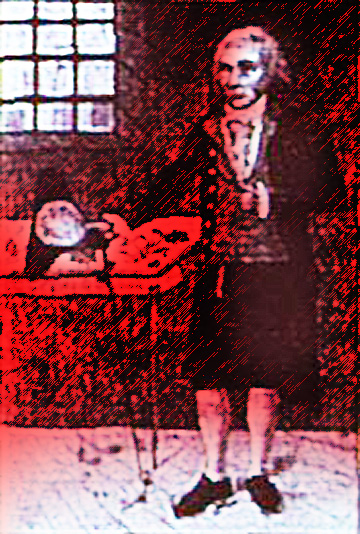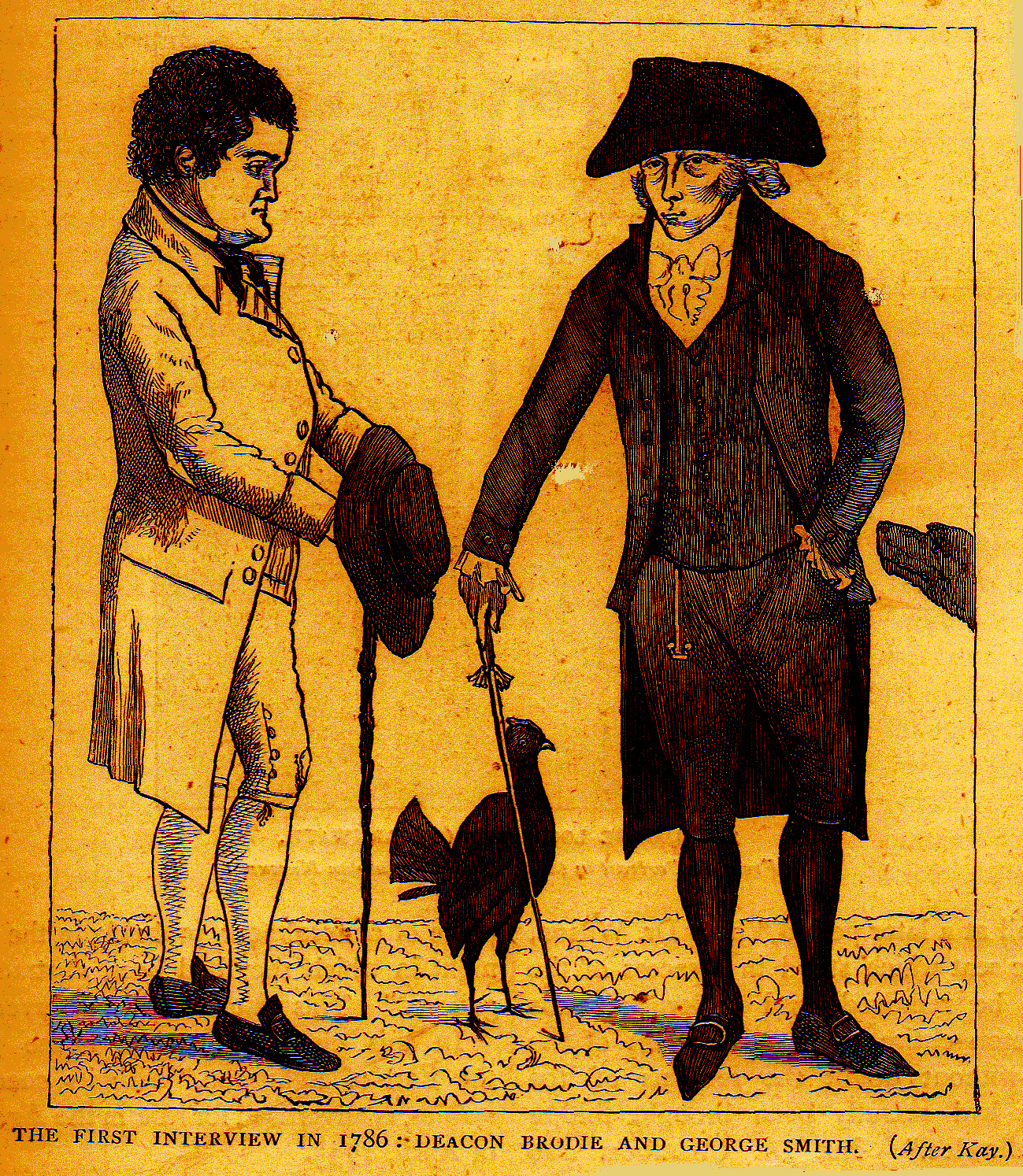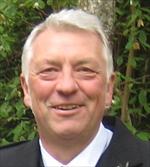|
DEACON BRODIE
by Tom Doran
Scotland's Real Life Inspiration for Dr. Jekyll & Mr. Hyde
In 18th Century Edinburgh, a city famous for more than its fair share of intrigue and scoundrels, William Brodie - Deacon William Brodie - stands out as one of the most colorful. His tainted career served Scottish author Robert Louis Stevenson well on two accounts. One, as the title character of a play about his life, co-written with W. Henley, but more importantly as the inspiration for one of literature's most famous books – "The Strange Case of Dr. Jekyll & Mr. Hyde."

Brodie was the son of a well-known cabinetmaker, and even though he inherited a great sum of money upon his father's death (as well as his highly respected business), he could not keep a dark side of his nature from rearing its decadent head.
He roamed the dark, dangerous streets of Edinburgh by night. Frequenting the most disreputable and hellish whorehouses, gambling dens, and pubs. His companions were the worst sort – drunkards, whore-masters, burglars, and worse. He gambled constantly and recklessly, incurring great debts.
But none of this activity was known to the city elders, and other pillars of the community. Brodie even became a respected member of the Town Council (hence his title of "Deacon"). His talents as a cabinet-maker, tutored as he was by his illustrious father, were well known and appreciated by the wealthy members of society who eagerly, and unknowingly, allowed a dangerous wolf in amongst the sheep. With legitimate access to impressive houses, he secretly made wax impressions of the door keys. When the time was right, and with an inside knowledge of the comings and goings of his patrons, he returned time and again, to house after house, to pilfer property, valuables, and money.
His mysterious, addictive nightlife continued unabated. He acquired two mistresses, and sired at least 5 or 6 illegitimate children. As the cash gains grew, he sought out other burglars to help him, which included a "lock smith" – an English criminal named George Smith. Deacon Brodie had it "made" as it were, moving easily among the gentry during the day, and exalting in criminal escapades at night. The thrill of it all was intoxicating.
He continued undiscovered for years – even hobnobbing with such well-known characters as Scotland's most famous poet Robert Burns – and Scotland's best painter, Raeburn. This only emboldened him – and set him firmly on the path to his own manufactured downfall.
In what was a typical, but poorly conceived and overly ambitious plan, Brodie and his minions decided to rob the excise office (the tax office) of Edinburgh. It promised to net an enormous sum, and Brodie, foolishly feeling invulnerable because of his successful double-life, set the play in motion.

He enlisted the aid of yet two more burglars – John Brown and Andrew Ainslie and on the 5th day of March, 1788 they struck. Sort of. One story has it that Brodie, probably being very intoxicated actually fell asleep during the midnight break-in (being an upstanding citizen all day, and carousing at night was bound to catch up with him)! They just made it away, but not with all the intended swag.
The city, alarmed as they were at all the unsolved, and escalating night-time break-ins, had had quite enough, and soon issued a reward – even bringing their focus to Brodie himself. There were just one too many coincidences.
Brown was the first to break – turning in two of his comrades was bound to let him get off with a reduced sentence – even the possibility of getting off "Scot Free" as it were. Ainslie and George Smith were captured and thrown in the clink.
The Deacon decided that the jig was indeed up, and caught the next boat to the Netherlands. From there he planned to sail to the America's when the long arm of the law caught up with him – just as he was boarding the ship to freedom.
n Edinburgh, Brodie's capture and trial captivated the capitol city as perhaps no other had before or since. But soon after, the man who led the most secret of lives, was found guilty. The sentence - death by hanging. On October 1st, 1788, Deacon William Brodie and George Smith were put to death before a crowd estimated at over 40 thousand. The story goes that the gallows used were of a new type introduced by Brodie himself (if not actually self-designed and built)!
But even here the tale does not end, instead taking a wonderful, or at least colorful turn. Convinced still of his skillful talents, the story goes that Brodie engaged a willing surgeon to put a bendable metal tube down his throat - the thought being that the gallows rope would then not be able to break his neck. Another story has it that he paid the hangman to slip the noose around small hooks attached to a harness which would give the very vivid impression of being hanged, but would actually do little harm.
.jpg)
When the deed was done, William Brodie's body was taken by "friends" to a doctor in an attempt to revive him. Did they succeed? Had the man of mystery and master of deceit actually managed to pull off one final scam? No one knows for sure. Stories soon circulated that Brodie was seen walking the streets of continental Europe.
When his grave was finally opened some time later, the coffin was empty. A lifeless corpse spirited away by friends to enhance a growing legend? Or did Deacon Brodie sail away to a full, contented, and no doubt debauched life? We will never know.
In present day Edinburgh you can visit a well-known pub named for him, complete with a full-size statue of Brodie that stands just outside.
Besides the somewhat obscure play based directly on him, he was also the subject of a 1950's Australian radio serial (53 episodes!) that featured Rod Taylor in an on-going role (not as Brodie); a song; and in the 1990's finally became the subject of a feature film, starring Billy Connolly as the Janus-faced criminal.
Announcement of new Executive Director
11 November 2011
The Saltire Society is pleased to announce the appointment of Jim Tough to the post of Executive Director. Mr Tough, who is currently Executive Director North for the Arts Council England, previously worked as Chief Executive of the Scottish Arts Council, and has been involved in the cultural scene in Scotland for more than 10 years.

His role will be to raise the profile of the Saltire Society, one of Scotland’s oldest and most influential cultural bodies, as an independent voice celebrating and promoting Scottish achievements in arts, culture, science and the built environment.
The appointment of an Executive Director implements a key recommendation of the Saltire Commission, chaired by Lord Cullen of Whitekirk, on the role of the Society in contemporary Scotland.
Saltire Society Chairman Lorimer Mackenzie said “After 75 years of promoting awareness of Scotland’s diverse culture and heritage the Saltire Society can confidently embark on its future knowing we have Jim Tough’s knowledge and experience assisting us. I am very pleased.”
Magnus Linklater, President of the Society, said: “I am delighted that Jim Tough is joining us. He is a great champion of the arts, widely known and respected across Scotland, and I know he will bring enormous energy to a role that will be increasingly important as the arts fights its corner in the Scotland of today.”
Mr Tough said "It will be great privilege to work for the Saltire Society which has served the country well over the last 75 years. I am excited by the potential we have in looking forward and playing a revitalised role in contemporary Scotland. The Saltire Society offers a uniquely independent voice that will celebrate, promote and advocate for the best of our achievements as a nation. Now is the right time for that voice to be heard again. "
PAGE ONE
TABLE OF CONTENTS
PAGE THREE
|